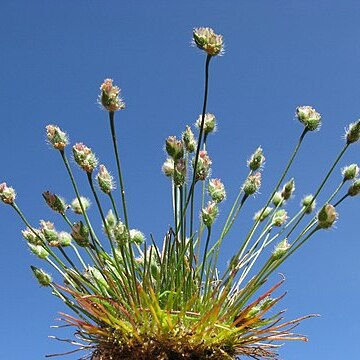Herb, annual, 2–11 cm high. Leaves basal, regularly radiating; sheath 2–8 mm long, pilose; lamina straight, linear-subulate, 7–30 mm long, c. 0.4 mm wide, pilose with patent hairs or rarely glabrous. Cataphyll obtuse, 3–6 mm long. Scape terete, 1–10 cm long, glabrous or finely pilose. Heads terete, broadly ovoid, 2–4 mm wide. Primary bracts separated by an internode 1–2 mm long, gaping at anthesis, similar; basal sheath broadly cymbiform, 2–3 mm long, herbaceous, strigose to glabrous with glabrous mucros 0.5–1.3 mm long. Pseudanthia 10–20, all bisexual. Secondary bracts 2 or 3 per pseudanthium, 2–2.5 mm long, obtuse to truncate, erose. Stamen free; anther 0.5–1.1 mm long. Gynoecium of 4–8 carpels; styles connate at the base; papillae simple, minute. Seed ovoid, c. 0.5 mm long.
Small tufted annual, 1.5-7 cm high, hispid throughout with white, rigid, multicellular hairs. Leaves 1-3 cm long, all basal, filiform; lamina broadening at base to membranous sheath; tip acicular. Scapes 2-7 cm long, much > leaves; glume-like bracts 2, occasionally 3, c. 3 mm long, green or pinkish, ovate, spreading; awn glabrous c. 1 mm long with acicular tip. Pseudanthia 4-8 in each bract, ± = bracts, each with 3 hyaline fringed bracteoles, one very short, one sheathing male flower, one sheathing female flowers. Male flower 1 in each pseudanthium; female flowers 4-8 in each pseudanthium, connate and superposed in 2 rows; styles not connate. Seeds c. 0.5 mm long, obovate-oblong, blunt at top, testa faintly reticulate, brown with dark tip at each end.

